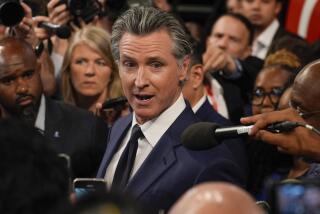4 takeaways from Newsom’s budget proposal

- Share via
SACRAMENTO — The Newsom administration on Friday released the governor’s initial spending plan for the upcoming 2025-26 budget year, which typically acts as a starting point for negotiations with lawmakers about the programs and policies they want to prioritize.
But very little about this budget process and the presentation has been normal.
Gov. Gavin Newsom skipped the traditional budget roll out at the state Capitol. He originally was going to attend former President Carter’s funeral and ultimately remained in Southern California to oversee the state’s response to the wildfires blazing through Los Angeles County. He instead offered a brief, and largely optimistic, overview of the state’s financial plan on Monday in Turlock.
California Director of Finance Joe Stephenshaw stepped up Friday to fill in more details during a news conference in Sacramento. His top-line message sounded similar to Newsom’s: California has a modest surplus and more revenue to spend than expected, though uncertainty looms about the future.
We dug into the $322-billion budget proposal and pulled out four facts you might want to know.
1. Subjective accounting
Newsom touted a “modest” budget surplus, which Stephenshaw pegged at $363 million. But the calculation of a surplus or a deficit in California is often subjective and this year is no different.
Newsom and lawmakers, as part of budget negotiations last year, reached a handshake agreement to make cuts, defer programs and take $7.1 billion out of the state’s rainy day fund, to address a projected shortfall in 2025-26. The early agreement is just that — it won’t actually be part of the budget until lawmakers approve it in June.
Under the proposal presented Friday, Newsom essentially counted the withdrawal from the rainy day fund as part of the state’s normal revenue stream, instead of a solution they’ll adopt when they pass the budget later this year. The change allows the administration to claim a surplus instead of a deficit.
“They’re taking money out of the savings account, and they’re calling that a surplus, which is wrong,” said state Sen. Roger W. Niello (R-Fair Oaks).
Though Stephenshaw said the governor has relied on this kind of accounting before, others said it marks a change from more traditional budget protocol.
California Gov. Gavin Newsom previewed his $322.2 billion budget proposal for 2025-2026 during a visit Monday to California State University, Stanislaus.
2. Fewer state jobs eliminated
Last year, Newsom said he would permanently eliminate 10,000 vacant state jobs to help offset the deficit. But none of them have been eliminated and the number changed to 6,500 jobs this week.
“We went through the steps of working with all departments and agencies and understanding what should or shouldn’t be included,” Stephenshaw said.
The lesser amount reflects a decision to not cut some firefighting jobs within the California Department of Forestry and Fire Protection, he said, among other emergency response positions.
It’s also an example of the fluid nature of agreements with lawmakers to cut funding in future budgets.
3. Another homelessness agency
Newsom’s budget proposal calls for a new “California Housing and Homelessness Agency to create a more integrated and effective administrative framework for addressing the state’s housing and homelessness challenges.”
The plan for a new agency comes less than a year after the governor added a Housing Accountability Unit at the California Department of Housing and Community Development to hold cities and counties accountable when they fail to adequately address homelessness.
The governor came under pressure in April when a state audit showed that his administration failed to track the results of billions of dollars spent on homelessness programs.
The administration said more details on the new agency will be available in the spring.
4. Less money returned to taxpayers?
For years the governor has bemoaned the fact that money set aside in California’s rainy day fund counts as expenditures toward the state’s spending limit.
Also known as the Gann Limit, the spending cap requires revenue collected over a certain threshold to be evenly split between education and returned to taxpayers.
In years of surplus, Newsom argues that the law prevents the state from being able to build up the rainy day fund for tougher economic times.
To change this, the governor proposes increasing a cap on deposits into the rainy day fund from 10% to 20% of general fund revenues and exempting the funds from the spending limit.
The proposal, which essentially allows the state to put more money into the rainy day fund, changes the California Constitution and requires voter approval. Newsom has previously acknowledged that it could be a hard sell to voters, as it would ask them to allow the government to keep more of their tax dollars.
More to Read
Sign up for Essential California
The most important California stories and recommendations in your inbox every morning.
You may occasionally receive promotional content from the Los Angeles Times.












